Effect of EMBr on Flow in Slab Continuous Casting Mold and Industrial Experiment of Nail Dipping Measurement
Abstract
:1. Introduction
2. Mathematical Model
2.1. Basic Assumptions
- (1)
- The molten steel flow in the FM is viscous and incompressible.
- (2)
- The molten steel is considered to be homogeneous, with constant thermophysical properties.
- (3)
- The influence of factors such as FM vibration on the flow field is not considered.
- (4)
- The density difference after solidification of the slab is ignored, and the molten steel in the FM is treated as a homogeneous medium.
- (5)
- The electromagnetic characteristics of liquid steel are uniform and isotropic, and the secondary magnetic field generated in the molten steel is ignored.
2.2. Electromagnetic Force Equation
2.3. Flow-Field Governing Equation
2.4. Boundary Conditions and Numerical Calculation
2.5. Validation of Models
3. Results and Discussion
3.1. Electromagnetic Field Calculations
3.2. The Influence of EMBr on Flow Pattern of Molten Steel
3.3. Influence of Magnetic Flux Density on Liquid-Level Shape of Steel/Slag
3.4. Industrial Test
3.4.1. Nail Dipping Measurement
3.4.2. Test Results of Molten Steel Flow at Liquid-Level
3.4.3. Test Results of Liquid-Level Profile
4. Conclusions
Author Contributions
Funding
Institutional Review Board Statement
Informed Consent Statement
Data Availability Statement
Conflicts of Interest
Abbreviations
| Acronyms | Words |
| FM | funnel mold |
| EMBr | electromagnetic braking |
| MHD | magnetohydrodynamics |
| NF | narrow face |
| SEN | submerged entry nozzle |
| FC-Mold | flow control mold |
| 3D | three-dimensional |
| FTSC | flexible thin-slab caster |
| VOF | volume of fluid |
References
- Thomas, B.G. Modeling of Continuous Casting Defects Related to Mold Fluid Flow. Iron Steel Technol. 2006, 3, 128–143. [Google Scholar]
- Zhang, L.M.; Zhu, L.G.; Tian, P.; Xiao, P.C.; Liu, Z.X.; Zhang, C.J. Analysis and control of peeling defects of 65Mn steel in cold rolling. Steelmaking 2020, 36, 63–69. [Google Scholar]
- Zheng, S.G.; Zhu, M.Y. Study on mechanism of mold powder entrapment in funnel type mould of flexible thin slab casting machine. Ironmak. Steelmak. 2014, 41, 507–513. [Google Scholar] [CrossRef]
- Yavuz, M.M. The Effects of Electromagnetic Brake on Liquid Steel Flow in Thin Slab Caster. Steel Res. Int. 2011, 82, 809–818. [Google Scholar] [CrossRef]
- Zhu, L.G.; Zhang, L.M.; Wang, X.J.; Zhang, C.J.; Han, Y.H.; Sun, L.G. Physical experiment and numerical simulation of flow field on funnel mold surface. Contin. Cast. 2021, 6, 2–8. [Google Scholar]
- Hibbeler, L.C.; Thomas, B.G. Mold Slag Entrainment Mechanisms in Continuous Casting Molds. Iron Steel Technol. 2013, 10, 121–134. [Google Scholar]
- Cho, S.M.; Kim, S.H.; Thomas, B.G. Transient Fluid Flow during Steady Continuous Casting of Steel Slabs: Part I. Measurements and Modeling of Two-phase Flow. ISIJ Int. 2014, 54, 845–854. [Google Scholar] [CrossRef] [Green Version]
- Qian, Z.D.; Wu, Y.L. Large Eddy Simulation of Turbulent Flow with the Effects of DC Magnetic Field and Vortex Brake Application in Continuous Casting. ISIJ Int. 2004, 44, 10–107. [Google Scholar] [CrossRef]
- Cho, S.M.; Thomas, B.G. Electromagnetic Forces in Continuous Casting of Steel Slabs. Metals 2019, 9, 741. [Google Scholar] [CrossRef] [Green Version]
- Liu, H.; Zhang, J.; Tao, H.; Zhang, H. Numerical analysis of local heat flux and thin slab solidification in a CSP funnel-type mold with electromagnetic braking. Metall. Res. Technol. 2020, 117, 602–605. [Google Scholar] [CrossRef]
- Weng, Y.M.; Han, Y.S.; Liu, Q. Optimization of multi-fields coupled molten steel behavior in bloom continuous casting. Iron Steel 2018, 53, 53–60. [Google Scholar]
- Chaudhary, R.; Thomas, B.; Vanka, S. Effect of Electromagnetic Ruler Braking (EMBr) on Transient Turbulent Flow in Continuous Slab Casting using Large Eddy Simulations. Metall. Mater. Trans. B 2012, 43, 532–553. [Google Scholar] [CrossRef]
- Xu, M.G.; Liu, H.P.; Xiang, L.; Qiu, S.T. Numerical simulation of transient fluid flow during casting start period in the CSP funnel-type mold with electromagnetic brake. Iron Steel 2014, 49, 28–33. [Google Scholar]
- Zhu, L.G.; Zhang, L.M.; Xiao, P.C.; Zheng, Y.H.; Jiang, Z.Y.; Zhao, J.P. Analysis and control of slag inclusion defects of low carbon steel slab. Contin. Cast. 2020, 45, 36–40. [Google Scholar]
- Xu, L.; Wang, E. Numerical Simulation of the Effects of Horizontal and Vertical EMBr on Jet Flow and Mold Level Fluctuation in Continuous Casting. Metall. Mater. Trans. B 2018, 49, 2779–2993. [Google Scholar] [CrossRef]
- Shibata, H.; Itoyama, S.; Kishimoto, Y.; Takeuchi, S.; Sekiguchi, H. Prediction of Equiaxed Crystal Ratio in Continuously Cast Steel Slab by Simplified Columnar-to-Equiaxed Transition Model. ISIJ Int. 2006, 46, 921–930. [Google Scholar] [CrossRef] [Green Version]
- Thomas, B.G. Review on Modeling and Simulation of Continuous Casting. Steel Res. Int. 2018, 89, 1700312. [Google Scholar] [CrossRef]
- Li, Z.; Xu, Y.; Wang, E.G. Numerical study on behavior of steel/slag interface and fluid flow in electromagnetic continuous casting mold of slab. Contin. Cast. 2016, 41, 1–8. [Google Scholar]
- Zhang, L.S.; Zhang, X.F.; Wang, B.; Liu, Q.; Hu, Z.G. Numerical Analysis of the Influences of Operational Parameters on the Braking Effect of EMBr in a CSP Funnel-Type Mold. Metall. Mater. Trans. B 2014, 45, 295–305. [Google Scholar] [CrossRef]
- Jin, K.; Vanka, S.P.; Thomas, B.G. Large Eddy Simulations of the Effects of EMBr and SEN Submergence Depth on Turbulent Flow in the Mold Region of a Steel Caster. Metall. Mater. Trans. B 2017, 48B, 162–178. [Google Scholar] [CrossRef]
- Tani, M.; Zeze, M.; Toh, T.; Tsunenari, K.; Umetsu, K.; Hayashi, K.; Tanaka, K.; Fukunaga, S. Electromagnetic Casting Technique for Slab Casting. Nippon. Steel Tech. Rep. 2013, 104, 62–68. [Google Scholar] [CrossRef]
- Kubo, N.; Ishii, T.; Kubota, J.; Ikagawa, T. Numerical Simulation of Molten Steel Flow under a Magnetic Field with Argon Gas Bubbling in a Continuous Casting Mold. ISIJ Int. 2004, 44, 556–564. [Google Scholar] [CrossRef] [Green Version]
- Kunstreich, S. Electromagnetic stirring for continuous casting-Part 2. Rev. Met. Paris 2003, 100, 1043–1061. [Google Scholar] [CrossRef]
- Thomas, B.G.; Singh, R.; Vanka, S.P.; Timmel, K.; Eckert, S.; Gerbeth, G. Effect of Single-Ruler Electromagnetic Braking (EMBr) Location on Transient Flow in Continuous Casting. J. Manuf. Sci. Prod. 2015, 15, 93–104. [Google Scholar] [CrossRef]
- Zhang, L.M.; Zhu, L.G.; Zhang, L.J.; Xiao, P.C.; Liu, Z.X. Optimization and application fo steel ladle insulation layer. China Metall. 2020, 30, 11–16. [Google Scholar]
- Yang, J.; Shi, P.Z.; Xu, L.J. Optimization of submerged entry nozzle structure for 250 mm thick slab mold. Contin. Cast. 2019, 44, 19–25. [Google Scholar]
- Xu, P.; Zhou, Y.Z.; Chen, D.F.; Long, M.J.; Duan, H.M. Optimization of submerged entry nozzle parameters for ultra-high casting speed continuous casting mold of billet. J. Iron Steel Res. Int. 2022, 29, 44–52. [Google Scholar] [CrossRef]
- Jin, X. Study on Fluid Flow Behavior of Molten Steel and Simulation Method in Slab Continuous Casting Mold. Ph.D. Thesis, Chongqing University, Chongqing, China, 2011. [Google Scholar]
- Wang, W.; Zhu, L.G.; Zhang, C.J.; Zheng, Q. Water flow field model and numerical simulation of 180 mm × 610 mm slab continuous casting mold. China Metall. 2020, 30, 46–53. [Google Scholar]
- Chen, W.; Zhang, L.; Ren, Q.; Ren, Y.; Yang, W. Large eddy simulation on four-phase flow and slag entrapment in the slab continuous casting mold. Metall. Mater. Trans. B 2022, 53, 1446–1461. [Google Scholar] [CrossRef]
- Zhang, L.; Li, Y.; Wang, Q.; Yan, C. Prediction model for steel/slag interfacial instability in continuous casting process. Ironmak. Steelmak. 2015, 42, 705–713. [Google Scholar] [CrossRef]
- Jin, K.; Thomas, B.G.; Ruan, X. Modeling and Measurements of Multiphase Flow and Bubble Entrapment in Steel Continuous Casting. Metall. Mater. Trans. B 2016, 47B, 548–565. [Google Scholar] [CrossRef]
- Hwang, Y.S.; Cha, P.R.; Nam, H.S.; Moon, K.H.; Yoon, J.K. Numerical Analysis of the Influences of Operational Parameters on the Fluid Flow and Meniscus Shape in Slab Caster with EMBR. ISIJ Int. 2007, 37, 659–667. [Google Scholar] [CrossRef]
- Garcia-Hernandez, S.; Morales, R.D.; Barreto, J.; Morales-higa, K. Numerical optimization of nozzle ports to improve the fluidynamics by controlling backflow in a continuous casting slab mold. ISIJ Int. 2013, 53, 1794–1802. [Google Scholar] [CrossRef] [Green Version]
- Zhang, Q.Y.; Wang, X.H. Numerical simulation of influence of casting speed variation on surface fluctuation of molten steel in mold. J. Iron Steel Res. 2010, 234, 15–18. [Google Scholar] [CrossRef]
- Harada, H.; Takeuchi, E.; Zeze, M.; Tanaka, H. MHD analysis in hydromagnetic casting process of clad steel slabs. Appl. Math. Modell. 1998, 22, 873–882. [Google Scholar] [CrossRef]
- Wang, Y.D.; Zhang, L.F.; Yang, W.; Ren, Y. Effect of nozzle type on fluid flow, solidification, and solute transport in mold with mold electromagnetic stirring. J. Iron Steel Res. Int. 2022, 29, 237–246. [Google Scholar] [CrossRef]
- Zhang, L.M.; Zhu, L.G.; Zhang, C.J.; Wang, Z.Q.; Xiao, P.C.; Liu, Z.X. Physical Experiment and Numerical Simulation on Thermal Effect of Aerogel Material for Steel Ladle Insulation Layer. Coatings 2021, 11, 1205. [Google Scholar] [CrossRef]
- Liu, R.; Sengupta, J.; Crosbie, D.; Chuang, S.; Trinh, M.; Thomas, B.G. Measurement of Molten Steel Surface Velocity with SVC and Nail Dipping during Continuous Casting Process; John Wiley & Sons, Ltd.: New York, NY, USA, 2011. [Google Scholar]
- Vakhrushev, A.; Kharicha, A.; Liu, Z.; Wu, M.; Ludwig, A.; Nitzl, G.; Tang, Y.; Hackl, G.; Watzinger, J. Electric current distribution during electromagnetic braking in continuous casting. Metall. Mater. Trans. B 2020, 51, 2811–2828. [Google Scholar] [CrossRef]
- Zhang, L.M.; Zhang, C.J.; Xiao, P.C.; Wang, Y.; Liu, Z.X.; Zhu, L.G. Heat transfer behaviour of funnel mould copper plates with high casting speed during different water supply processes. Ironmak. Steelmak. 2022, 49, 741–748. [Google Scholar] [CrossRef]
- Singh, R.; Thomas, B.G.; Vanka, S.P. Effects of a Magnetic Field on Turbulent Flow in the Mold Region of a Steel Caster. Metall. Mater. Trans. B 2013, 44B, 1201–1221. [Google Scholar] [CrossRef]
- Kunstreich, S.; Dauby, P.H. Effect of liquid steel flow pattern on slab quality and the need for dynamic electromagnetic control in the mold. Ironmak. Steelmak. 2005, 32, 80–86. [Google Scholar] [CrossRef]
- Ramirez-Lopez, P.E.; Lee, P.D.; Mills, K.C. Explicit modelling of slag infiltration and shell formation during mould oscillation in continuous casting. ISIJ Int. 2010, 50, 426–430. [Google Scholar] [CrossRef] [Green Version]
- Wu, X.; Wang, M.L.; Zhang, Y.L.; Zhang, H.; Zhang, K.F. Simulation study on influence factors of flow field in high-speed slab mold. Steelmaking 2020, 36, 27–33+49. [Google Scholar]
- Cho, S.M.; Thomas, B.G.; Lee, H.J.; Kim, S.H. Effect of Nozzle Port Angle on Mold Surface Flow in Steel Slab Casting. Iron Steel Technol. 2017, 14, 76–84. [Google Scholar]
- Rietow, B.; Thomas, B.G. Using Nail Board Experiments to Quantify Surface Velocity in the CC Mold. In Proceedings of the AISTech 2008, Pittsburgh, PA, USA, 5–8 May 2018. [Google Scholar]
- Liu, R.; Thomas, B.G.; Sengupta, J.; Chung, S.D.; Trinh, M. Measurements of Molten Steel Surface Velocity and Effect of Stopper-rod Movement on Transient Multiphase Fluid Flow in Continuous Casting. ISIJ Int. 2014, 54, 2314–2323. [Google Scholar] [CrossRef] [Green Version]
- Zhang, L.M.; Zhu, L.G.; Zhang, C.J.; Xiao, P.C.; Wang, X.J. Influence of submerged entry nozzle on funnel mold surface velocity. High Temp. Mater. Process. 2022, 41, 1–18. [Google Scholar]
- Ren, L.; Zhang, L.F.; Wang, Q.Q. Nail board experiments to investigate level characteristic in slab continuous casting mold. Iron Steel. 2016, 51, 49–54. [Google Scholar]
- Vakhrushev, A.; Kharicha, A.; Wu, M.; Ludwig, A.; Nitzl, G.; Tang, Y.; Hackl, G.; Josef Watzinger, J.; Rodrigues, C.M.G. Norton-hoff model for deformation of growing solid shell of thin slab casting in funnel-shape mold. J. Iron Steel Res. Int. 2022, 29, 88–102. [Google Scholar] [CrossRef]
- Zhang, L.M.; Zhu, L.G.; Zhang, C.J.; Xiao, P.C.; Liu, Z.X. Analysis and control of high carbon steel 50-2 stamping toe cap cracking. China Metall. 2021, 31, 44–49. [Google Scholar]
- Wang, Y.; Yang, S.; Wang, F.; Li, J. Optimization on reducing slag entrapment in 150 × 1270 mm slab continuous casting mold. Materials 2019, 12, 1774. [Google Scholar] [CrossRef]

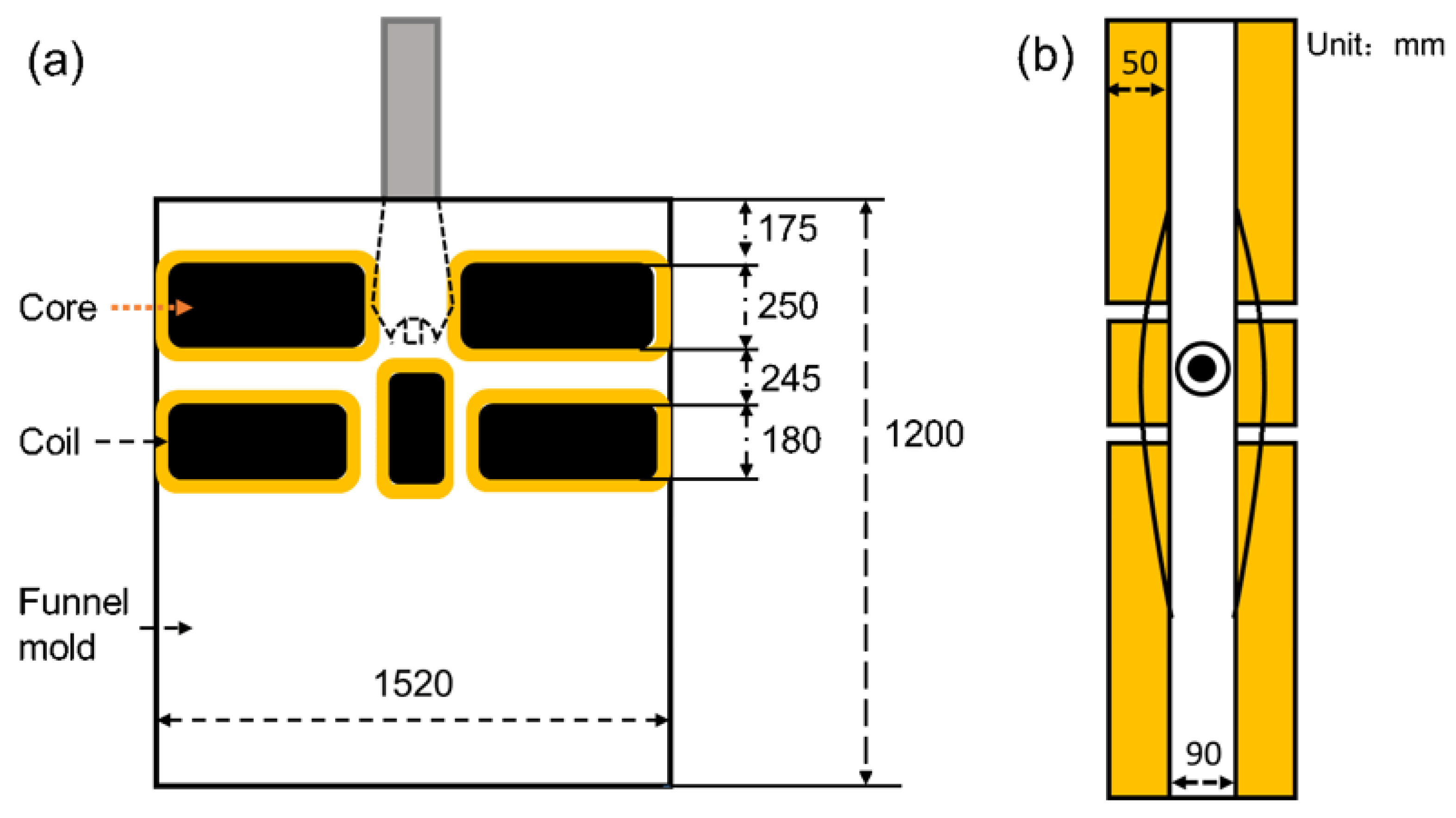
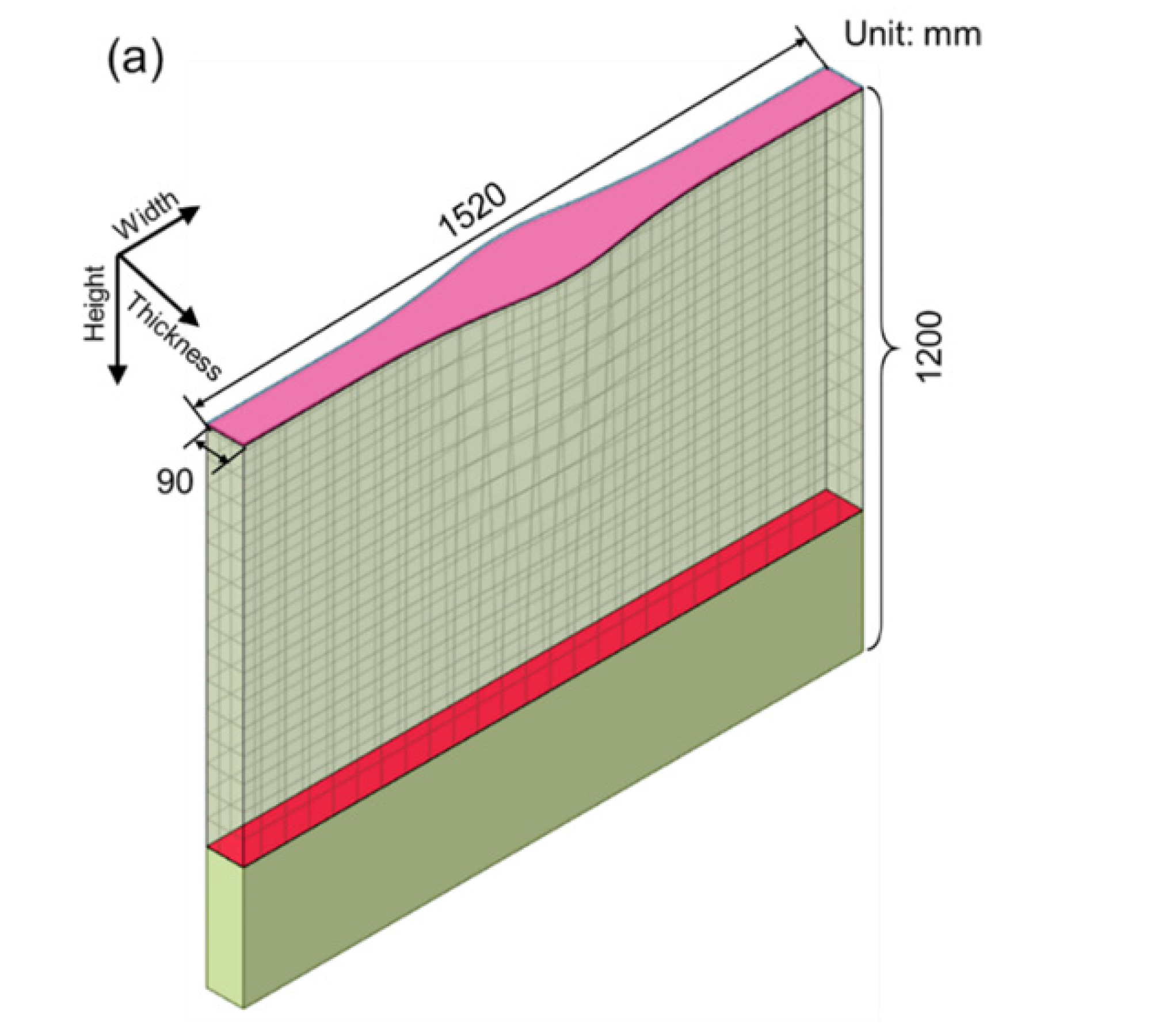
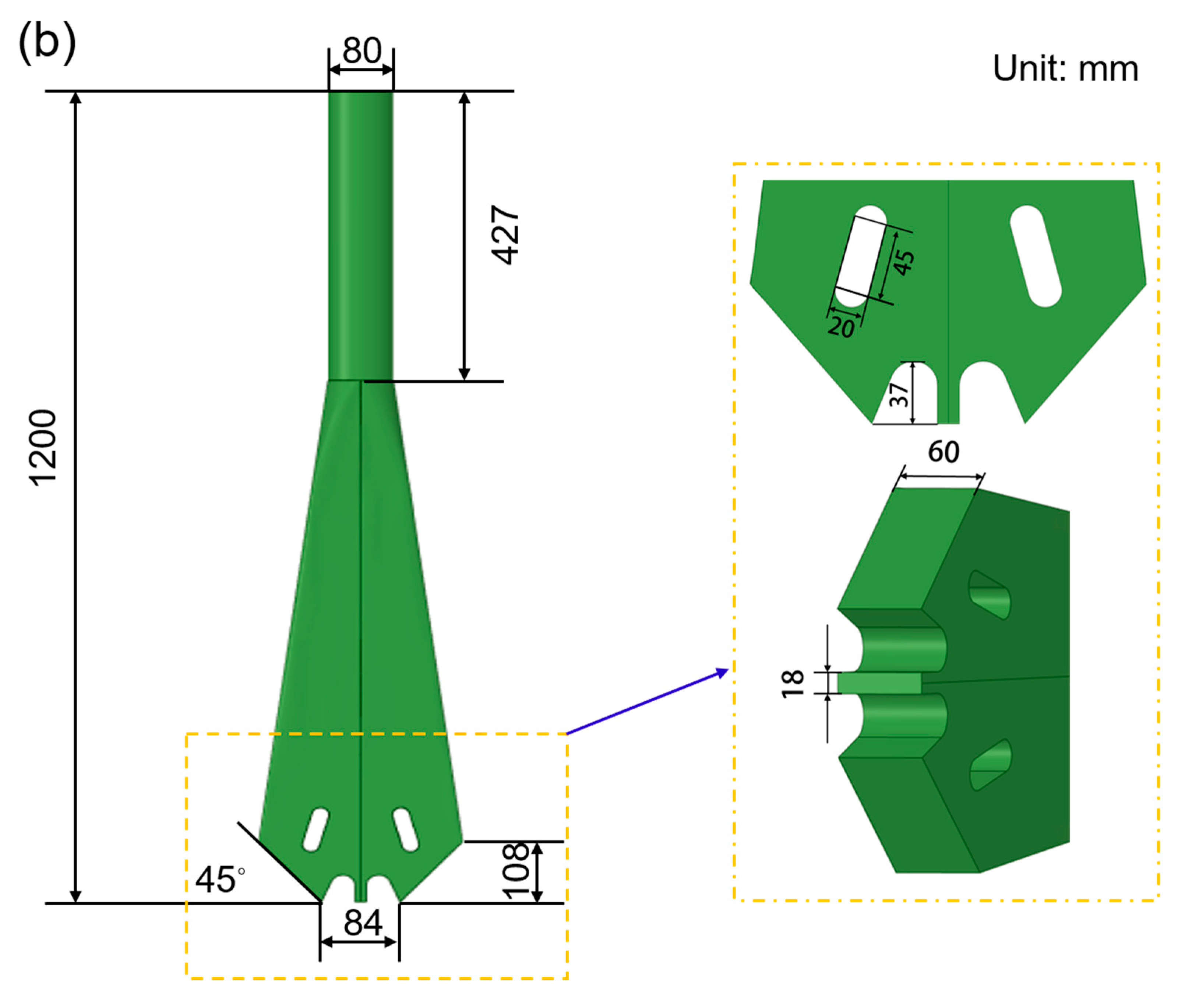
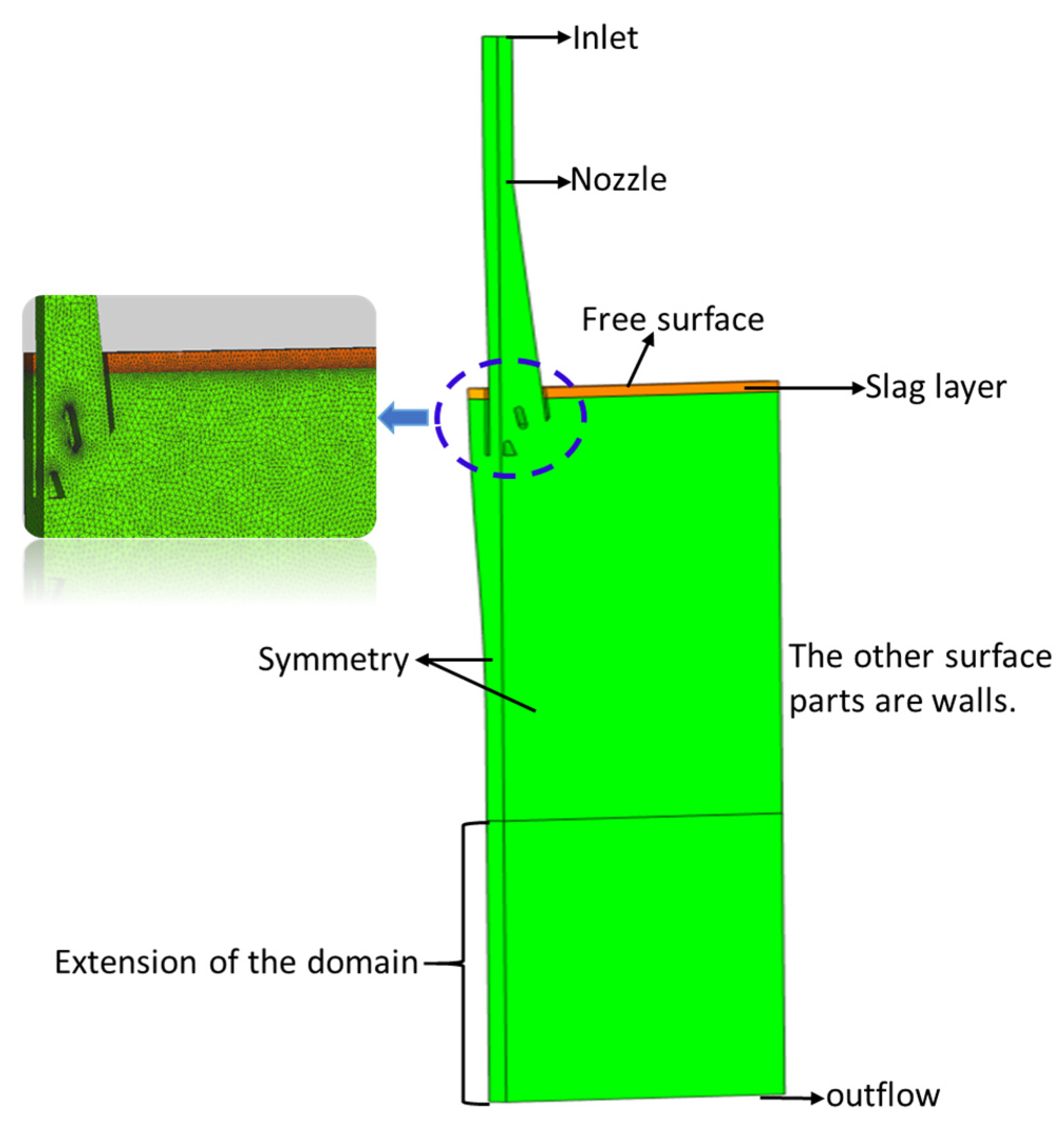


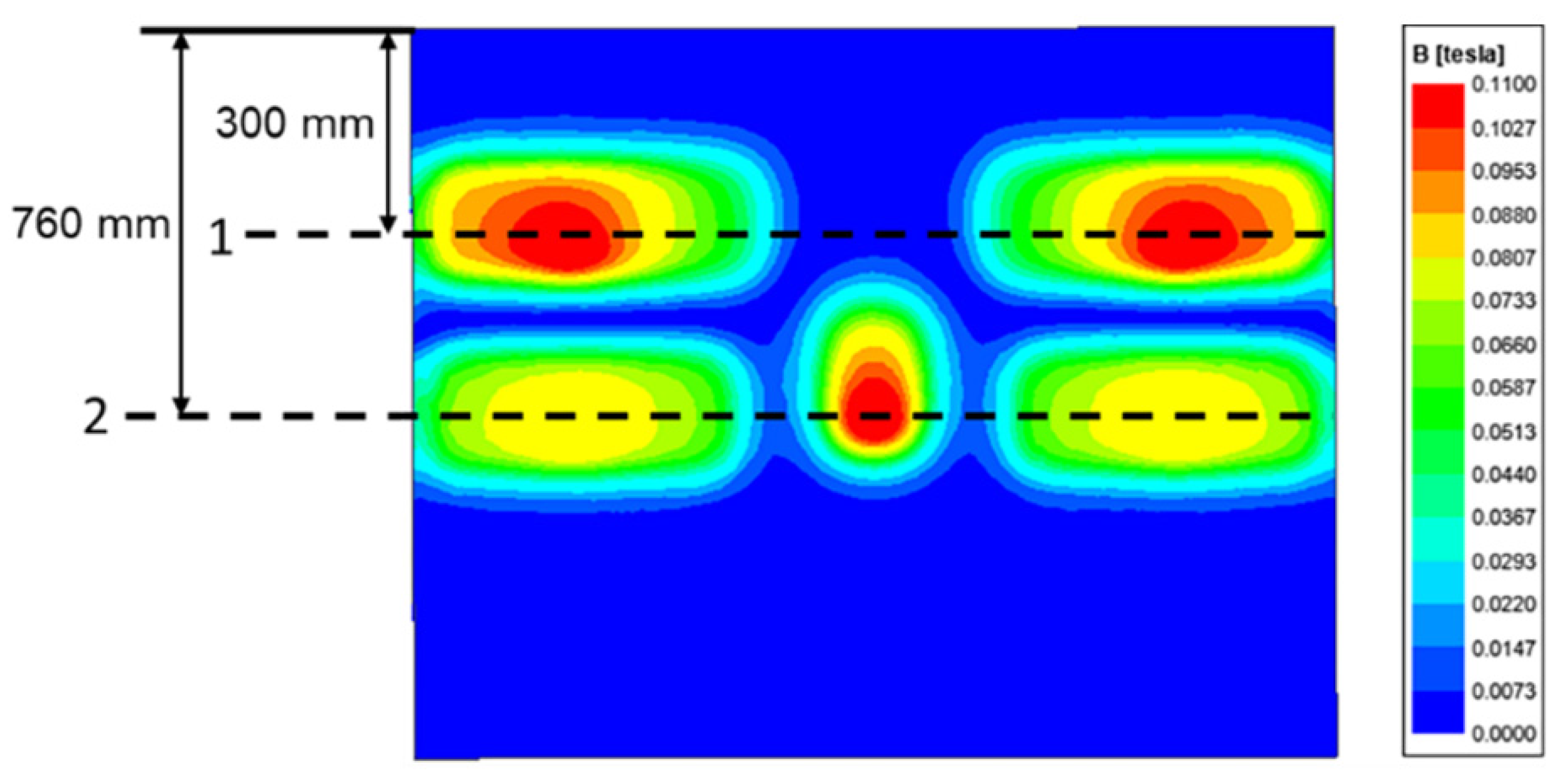
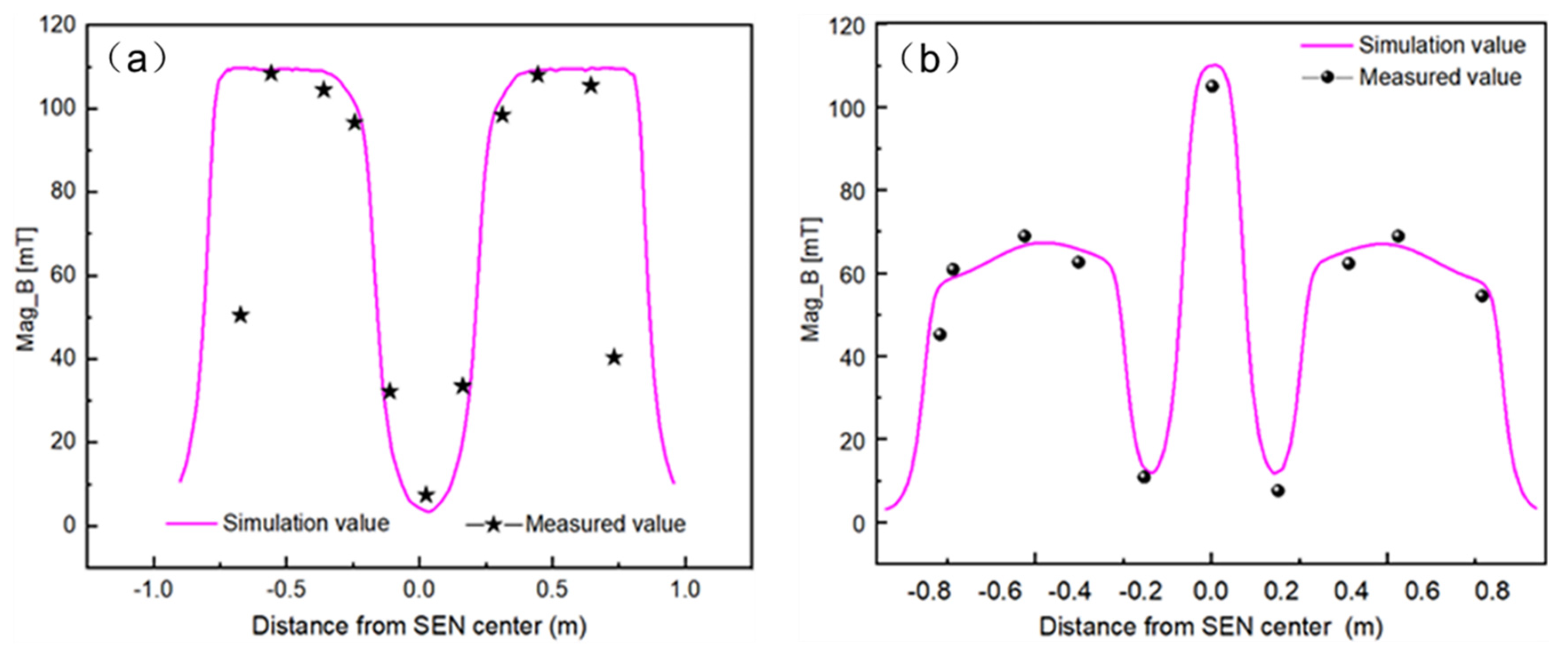

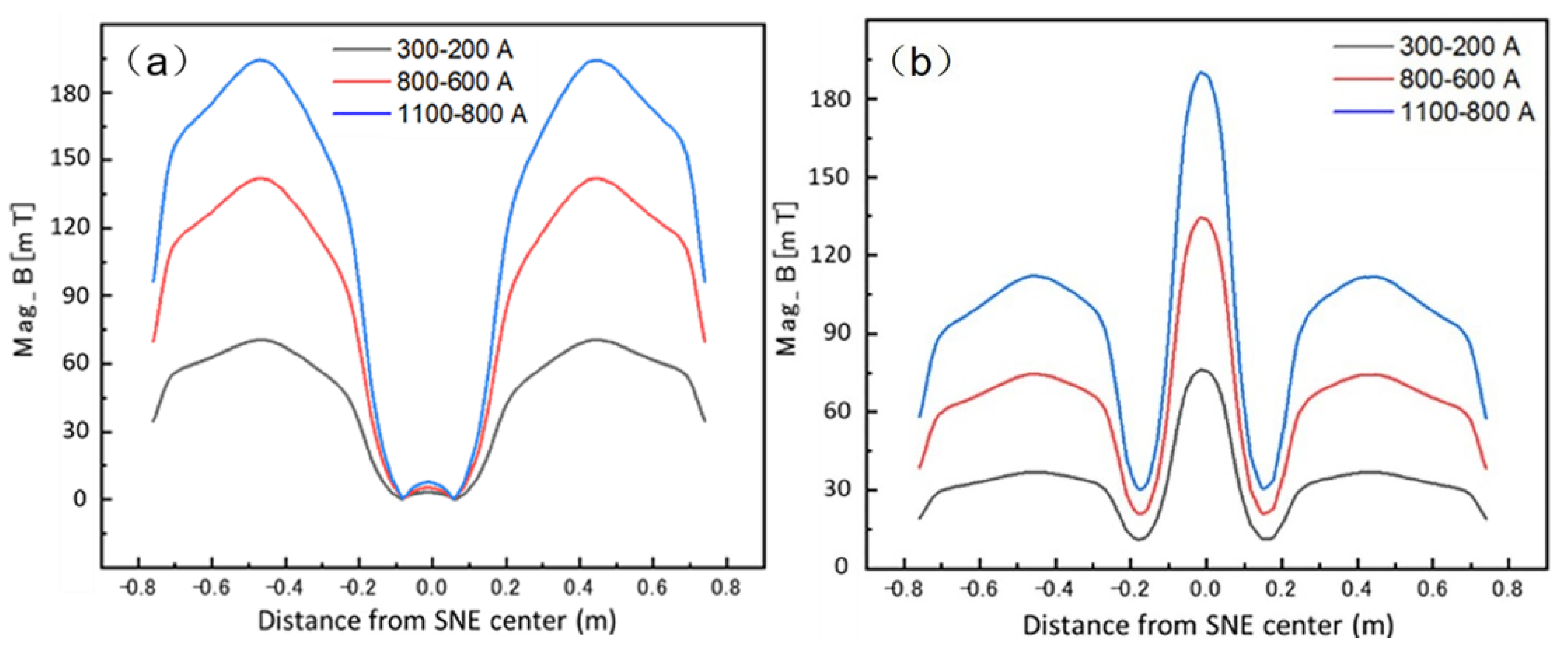
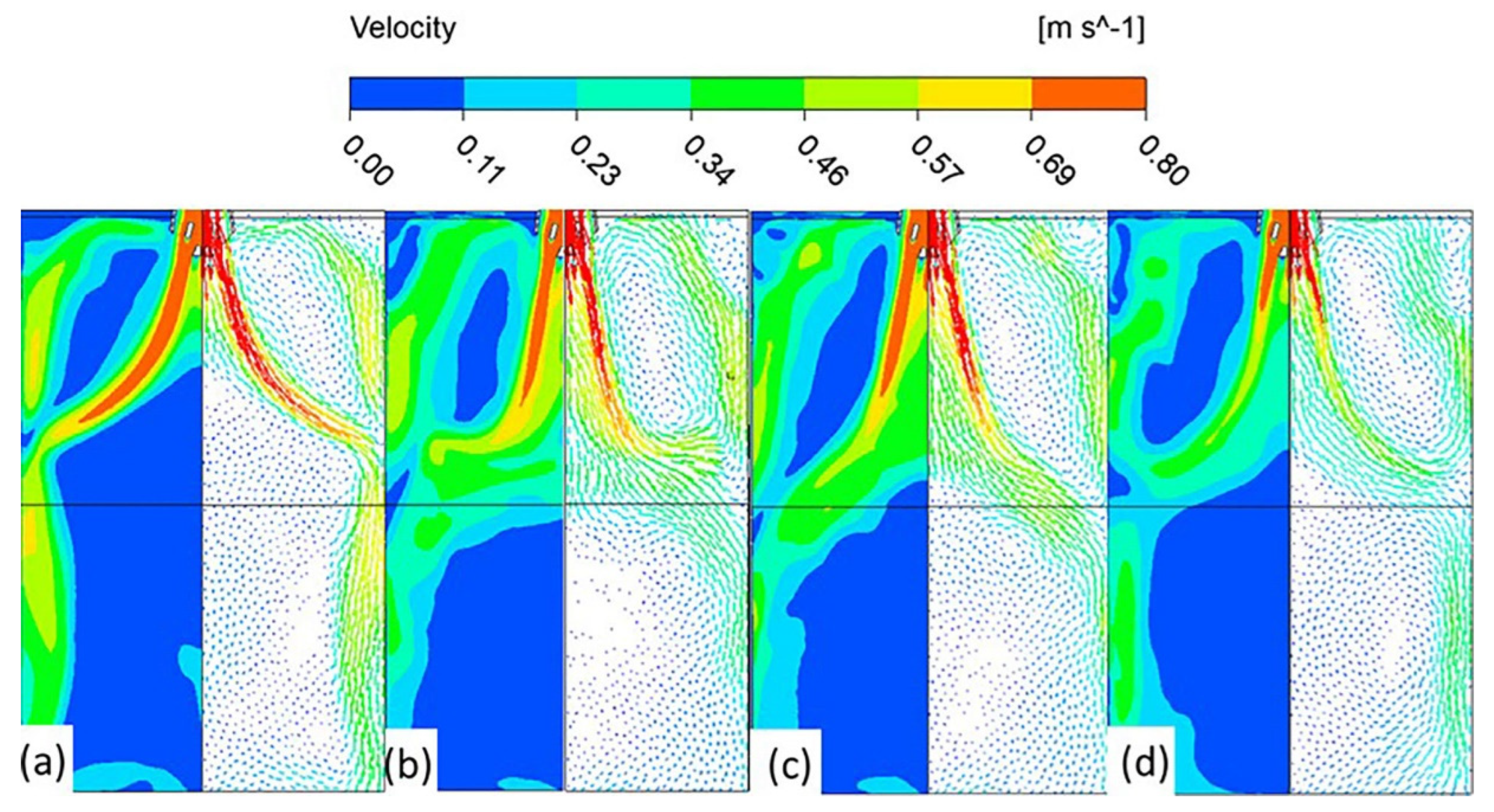

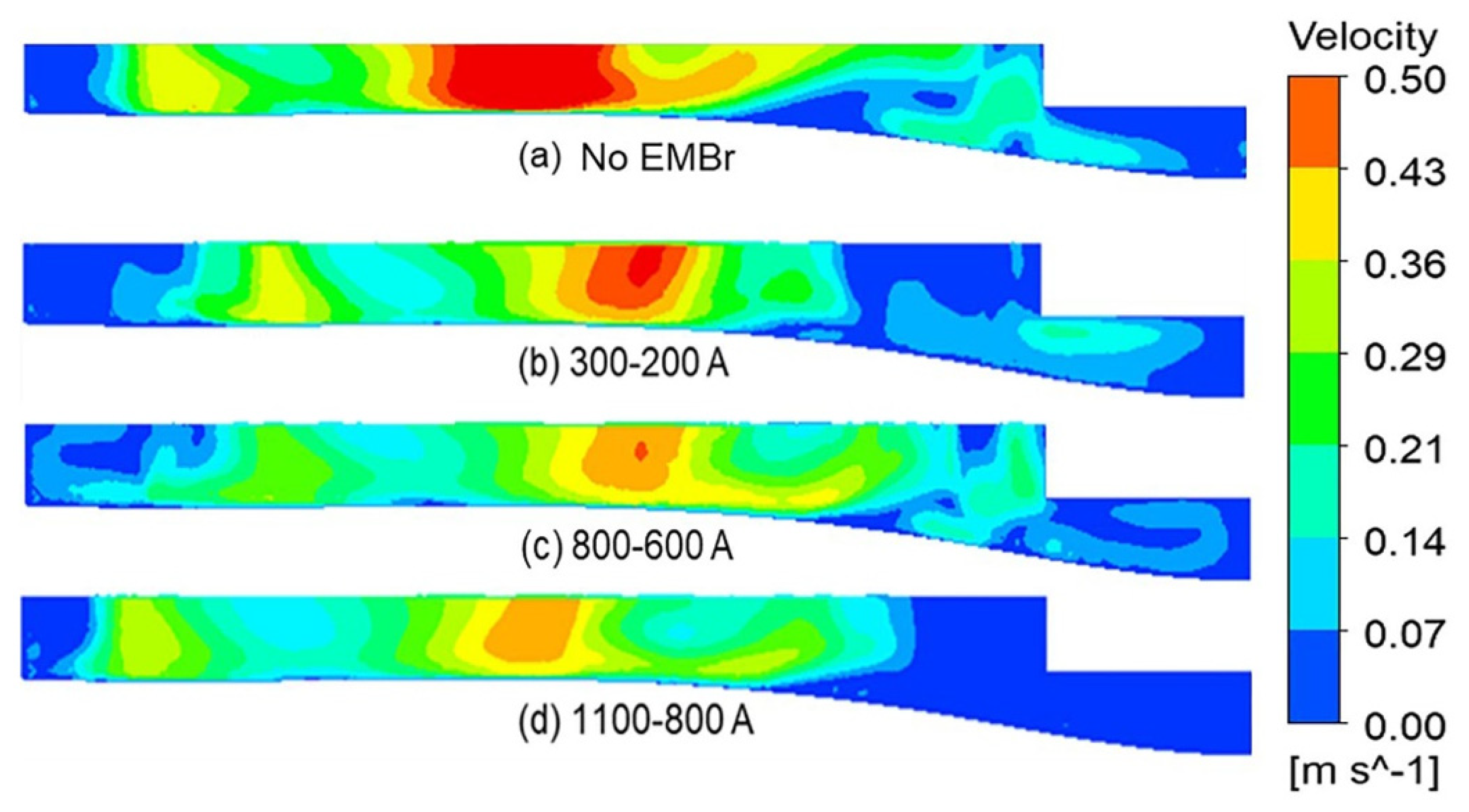
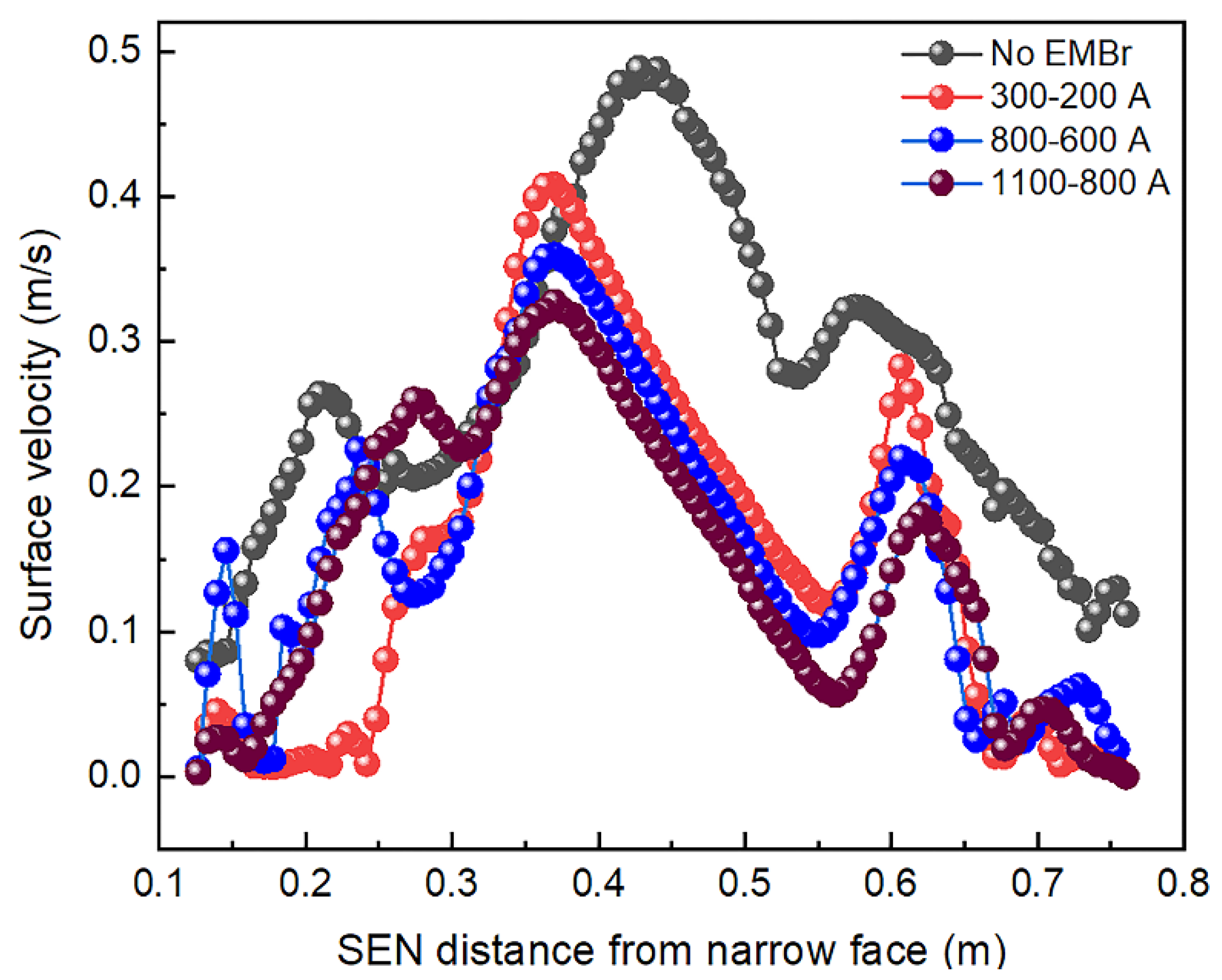
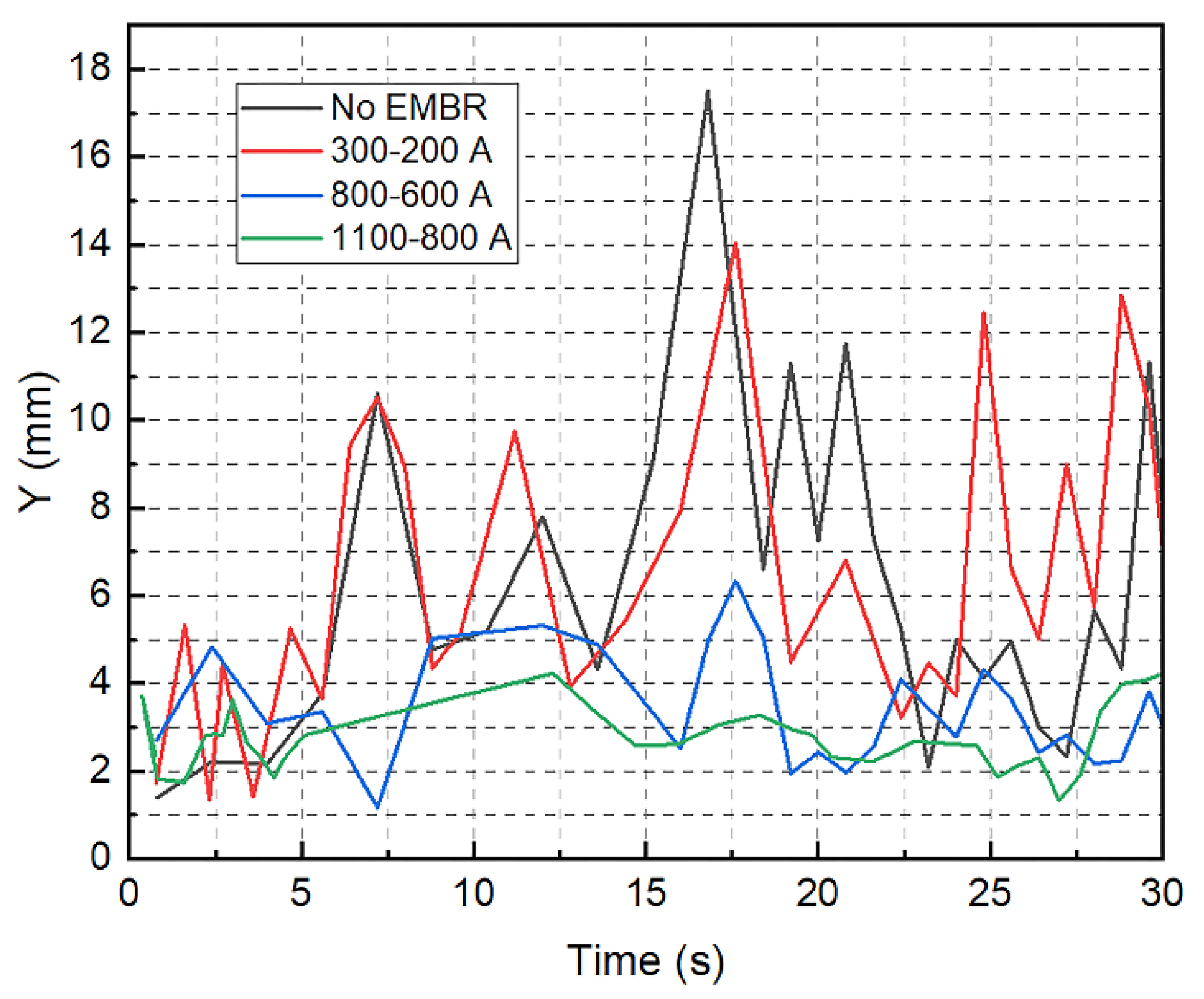

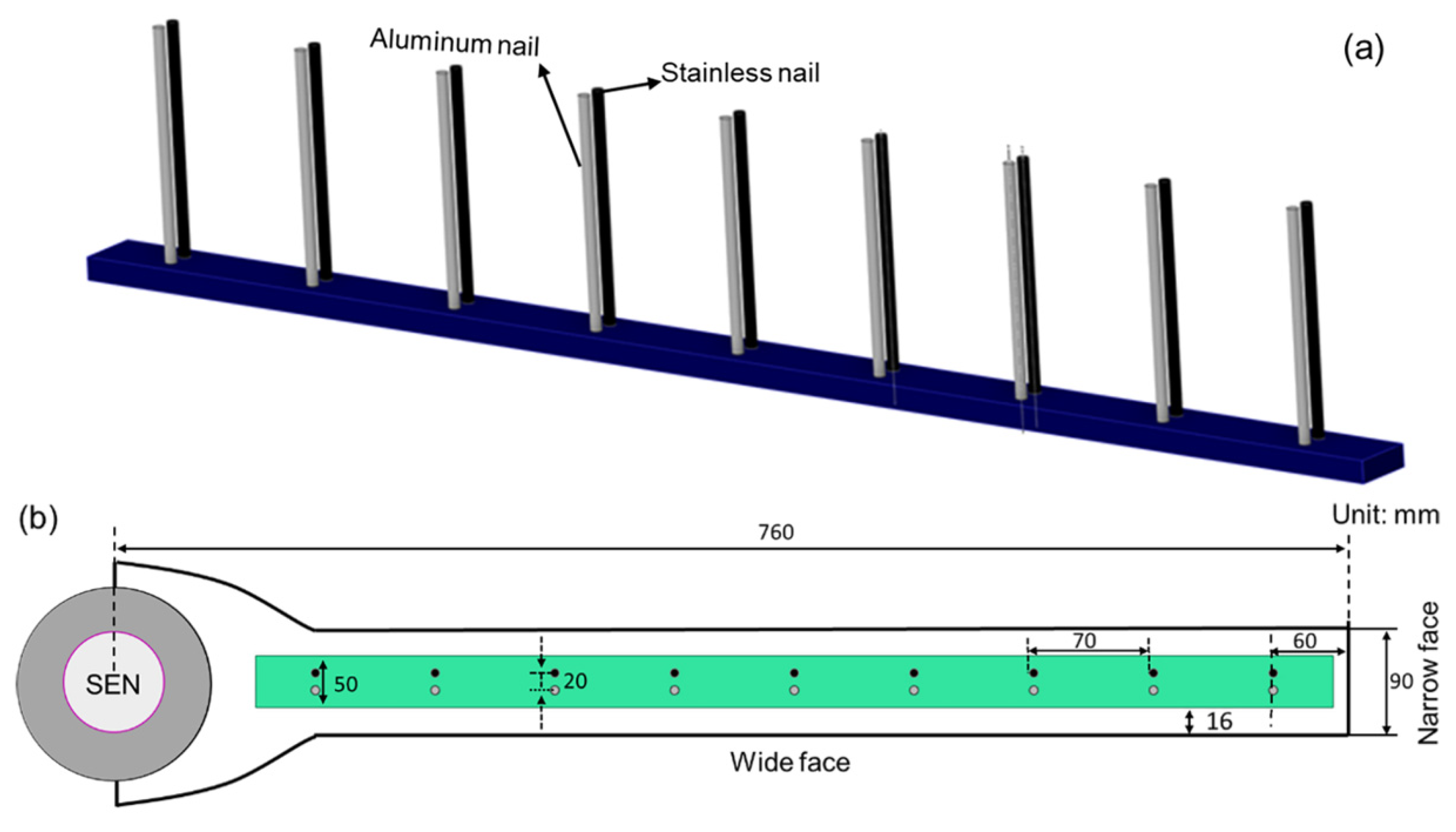


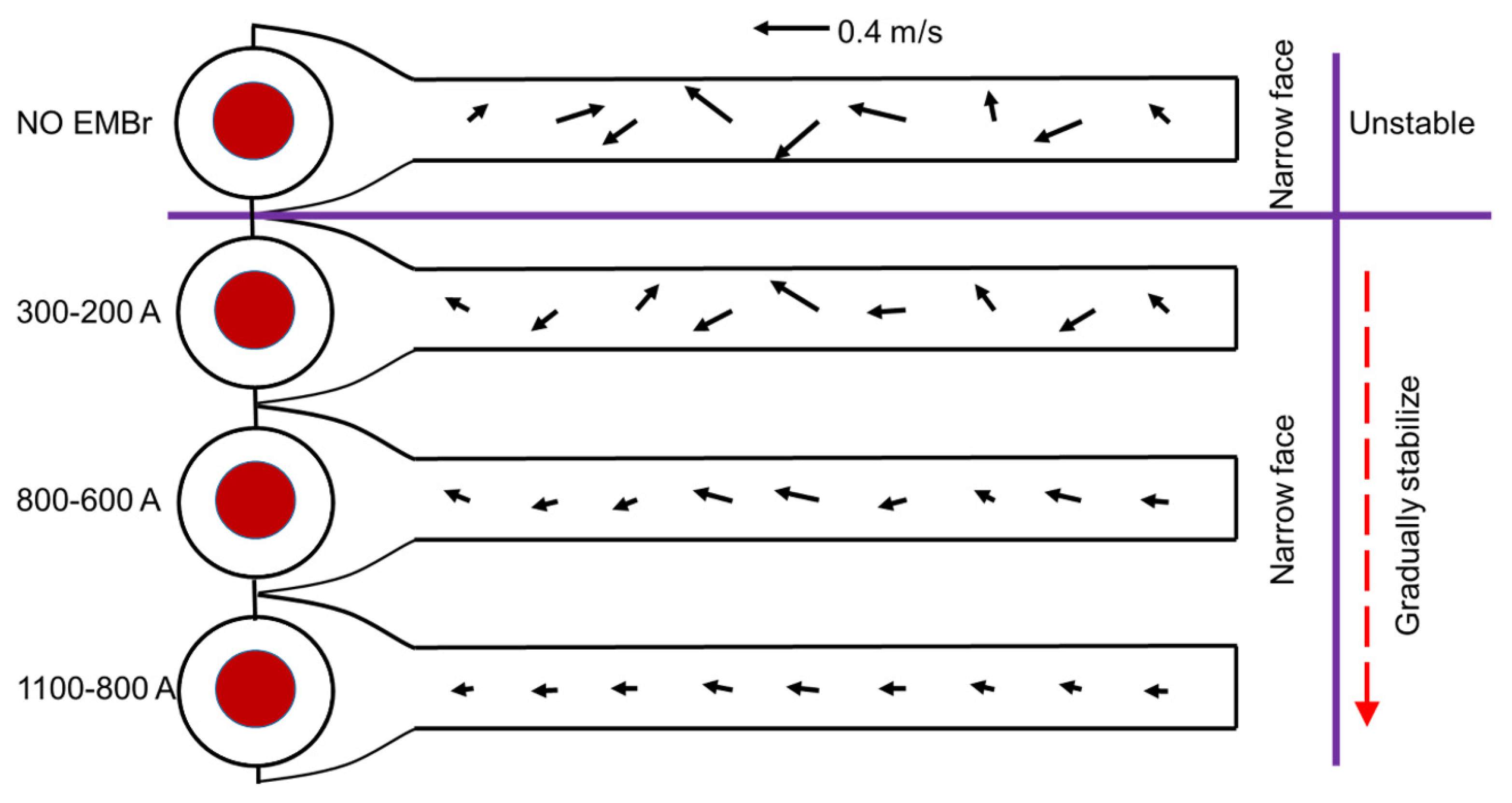
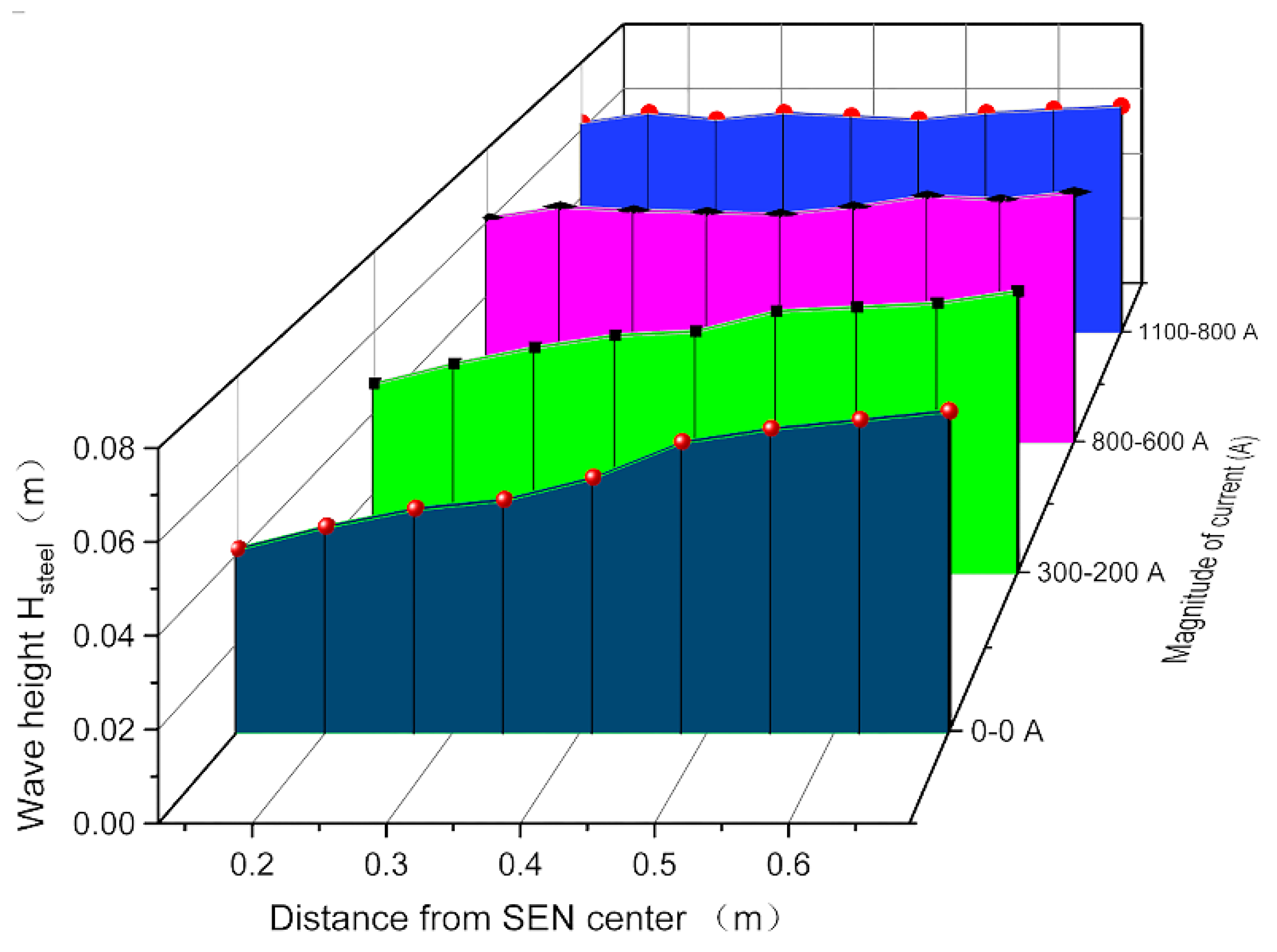

| Item | Value |
|---|---|
| FM width (mm) | 1520 |
| FM thickness (mm) | 90 |
| FM height (mm) | 1200 |
| SEN inlet diameter (mm) | 80 |
| SEN submergence depth (mm) | 160 |
| Casting speed (m/min) | 6 |
| Molten steel density (kg/m3) | 7020 |
| Molten steel viscosity (Pa·s) | 0.0064 |
| Slag/molten steel surface tension (N/m) | 1.3 |
| Liquid-slag density (kg/m3) | 2700 |
| Liquid-slag viscosity (Pa·s) | 0.18 |
| Core relative permeability | 4000 |
| Electrical conductivity of core (S/m) | 1.12 × 107 |
| Distance from core to FM domain (mm) | 50 |
| Thickness of copper coil (mm) | 65 |
| Copper coil relative permeability | 1 |
| Electrical conductivity of molten steel (S/m) | 7.14 × 105 |
| Air relative permeability | 1 |
| Electrical conductivity of air (S/m) | 1.0 × 10−5 |
| Number | Magnetic Pole (A/C) Coil Current | Magnetic Pole (F/D/E) Coil Current |
|---|---|---|
| 1 | 300 A | 200 A |
| 2 | 800 A | 600 A |
| 3 | 1100 A | 800 A |
Disclaimer/Publisher’s Note: The statements, opinions and data contained in all publications are solely those of the individual author(s) and contributor(s) and not of MDPI and/or the editor(s). MDPI and/or the editor(s) disclaim responsibility for any injury to people or property resulting from any ideas, methods, instructions or products referred to in the content. |
© 2023 by the authors. Licensee MDPI, Basel, Switzerland. This article is an open access article distributed under the terms and conditions of the Creative Commons Attribution (CC BY) license (https://creativecommons.org/licenses/by/4.0/).
Share and Cite
Zhang, L.; Xiao, P.; Wang, Y.; Zhang, C.; Zhu, L. Effect of EMBr on Flow in Slab Continuous Casting Mold and Industrial Experiment of Nail Dipping Measurement. Metals 2023, 13, 167. https://doi.org/10.3390/met13010167
Zhang L, Xiao P, Wang Y, Zhang C, Zhu L. Effect of EMBr on Flow in Slab Continuous Casting Mold and Industrial Experiment of Nail Dipping Measurement. Metals. 2023; 13(1):167. https://doi.org/10.3390/met13010167
Chicago/Turabian StyleZhang, Limin, Pengcheng Xiao, Yan Wang, Caijun Zhang, and Liguang Zhu. 2023. "Effect of EMBr on Flow in Slab Continuous Casting Mold and Industrial Experiment of Nail Dipping Measurement" Metals 13, no. 1: 167. https://doi.org/10.3390/met13010167





